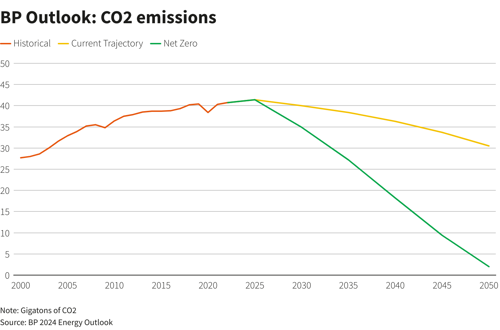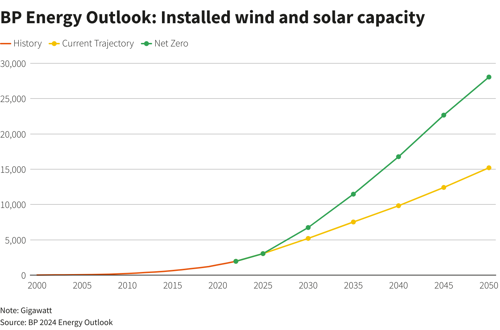bp Energy Outlook: Two main scenarios see 2025 oil peak, rapid renewables growth
bp expects oil demand to peak next year and wind and solar capacity to grow rapidly in both of the two main scenarios in its annual Energy Outlook, a study of the evolution of the global energy system to 2050 the company published on Wednesday.
Carbon emissions, caused predominantly by the burning of fossil fuels, also peak in the mid-2020s in both scenarios, which are:
- The Current Trajectory scenario is based on climate policies and carbon reduction pledges already in place.
- The Net Zero scenario assumes a significant tightening of climate policies aligned with the 2015 U.N.-backed Paris climate agreement to cut the world's carbon emissions by ~95% by the middle of the century.
Key points from the report are discussed in the following sections.

Energy demand and carbon emissions. Primary energy demand in the Current Trajectory rises up to the mid-2030s before broadly plateauing as continuing increases in energy consumption in emerging economies, excluding China, are broadly offset by declines in developed economies and eventually in China.
By 2050, energy demand in this scenario is around 5% higher than in 2022. By contrast, energy demand peaks in the middle of the current decade under the Net Zero scenario before declining thereafter. Energy demand is around 25% lower in 2050 compared with 2022.
Under the Current Trajectory scenario, carbon emissions are far off the net-zero ambition, which most of the world's largest economies have committed to achieving.

Oil. Oil demand is expected to peak by 2025 at around 102 MMbpd under both scenarios. However, it declines at a different pace in either outlook, driven primarily by the pace of falling oil use in road transport.
In the Current Trajectory, oil consumption gradually declines over the second half of the outlook to around 75 MMbpd in 2050. The drop in oil use is more pronounced in Net Zero, with demand falling to 25 MMbpd–30 MMbpd 2050.
The declining use of oil in road transport by 2035 is offset in the Current Trajectory by the increasing use of oil as a feedstock, especially in the petrochemicals sector as rising prosperity boosts consumption of plastics, textiles and other oil-based materials.

Natural gas and LNG. In the Current Trajectory scenario, natural gas demand continues to grow throughout the outlook, expanding by around a fifth by 2050.
The trend is driven by > 50% demand growth in emerging economies, excluding China, chiefly in the power and industrialized sectors. Chinese gas demand broadly plateaus in the 2040s and by 2050 is around a third higher than its 2022 level.
Under the Net Zero scenario, gas demand peaks by around the middle of this decade and by 2050 is around half of its 2022 level, driven by a rapid switch to alternative energies in developed economies.
Around 80% of natural gas consumption is abated through carbon capture and storage (CCS) technology by 2050.
In both scenarios, demand for liquefied natural gas (LNG), a super-chilled fuel that can be transported, grows rapidly until 2030, rising by 40% and 30% above 2022 levels in the Current Trajectory and Net Zero, respectively.
LNG demand increases by > 25% over the subsequent 20 yr. This demand growth requires 300 Bm3y of additional liquefaction capacity to come online post 2030.
In contrast, the gains in LNG demand out to 2030 in Net Zero are reversed over the following decade, and by 2050 global trade in LNG is around 40% below its 2022 level, implying that no additional liquefaction capacity beyond that already under construction is required.

Wind and solar. Wind and solar capacity increase around eight-fold by 2050 in the Current Trajectory scenario and by a factor of 14 in Net Zero from 2022 levels.
Until 2035, the buildout of new capacity is concentrated in China and developed economies, each of which account for 30%–45% of the increase in new capacity across the two scenarios.
The rapid expansion in wind and solar power is underpinned by further cost declines as technology and energy production costs continue to benefit from ever-increasing deployment levels.






Comments